英语国家概况
- 格式:doc
- 大小:64.50 KB
- 文档页数:31
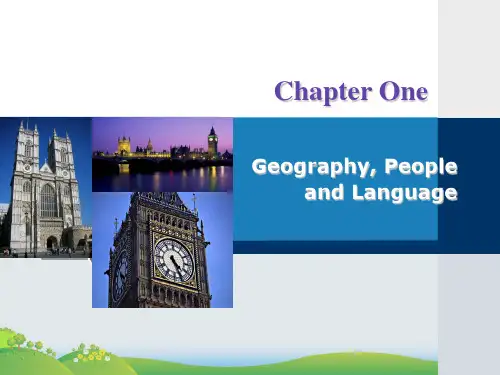
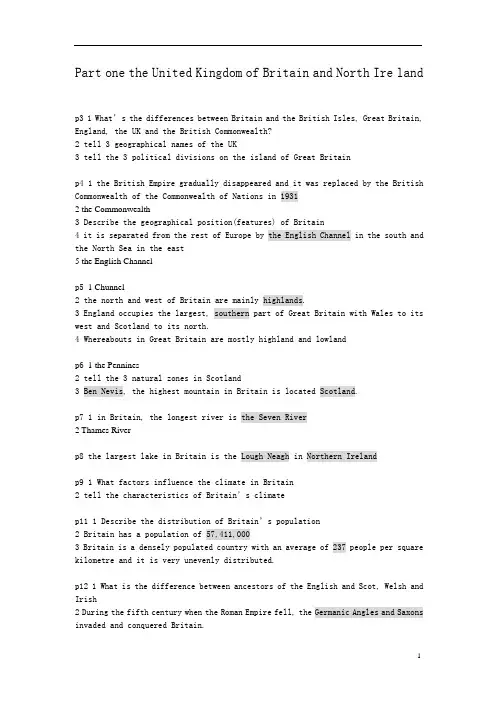
Part one the United Kingdom of Britain and North Ire landp3 1 What’s the differences between Britain and the British Isles, Great Britain, England, the UK and the British Commonwealth?2 tell3 geographical names of the UK3 tell the 3 political divisions on the island of Great Britainp4 1 the British Empire gradually disappeared and it was replaced by the British Commonwealth of the Commonwealth of Nations in 19312 the Commonwealth3 Describe the geographical position(features) of Britain4 it is separated from the rest of Europe by the English Channel in the south andthe North Sea in the east5 the English Channelp5 1 Chunnel2 the north and west of Britain are mainly highlands.3 England occupies the largest, southern part of Great Britain with Wales to itswest and Scotland to its north.4 Whereabouts in Great Britain are mostly highland and lowlandp6 1 the Pennines2 tell the3 natural zones in Scotland3 Ben Nevis, the highest mountain in Britain is located Scotland.p7 1 in Britain, the longest river is the Seven River2 Thames Riverp8 the largest lake in Britain is the Lough Neagh in Northern Irelandp9 1 What factors influence the climate in Britain 2 tell the characteristics of Britain’s climatep11 1 Describe the distribution of Britain’s population2 Britain has a population of 57,411,0003 Britain is a densely populated country with an average of 237 people per squarekilometre and it is very unevenly distributed.p12 1 What is the difference between ancestors of the English and Scot, Welsh and Irish 2 During the fifth century when the Roman Empire fell, the Germanic Angles and Saxonsinvaded and conquered Britain.13 It was from the union of Norman conquerors and the defeated Anglo-Saxons that theEnglish people and the English language were born.p13 1 What are the differences in character and speech between southern England andnorthern England2 in Britain, southerners speak the type of English closer to BBC English3 Cockney4 the ancestors of the Welsh were the ancient Britonsp14 1 Eisteddfodau2 How do the Welsh keep their language and culture?3 What’s the main problem in North Ireland?p15 1 the immigrants came from the West Indies, India and Pakistan(排除型选择)2 Which part of Britain has the most rainfall and which part is the driest?p16 1 the first known settlers of Britain were the Iberians2 Why do we say that English nation is a mixture on nationality of different origin?p17 1 Earliest invasion of England is by Celts2 the Celts began to arrive about 700 BC and kept coming until the arrival of theRomans.p18 1 the Celts’s religion was Druidism2 British recorded history begins with the Roman invasion3 Julius Caesar4 for nearly 400 years Britain was under the Roman occupationp19 1 Hadrian’s Wall2 Antonine Wall3 York had been created as a northern strongholdp20 1 the first Christian Emperor, Constantine, was proclaimed in AD 3062 tell why the Roman impact upon the Britons was surprisingly limited3 Who were the Anglo-Saxons, how did Heptarchy come into being?p21 1 Angles2 seven principal kingdoms3 Heptarchy4 when the Northumbrians submitted to him and took him for their master in 829,Egbert actually became an overlord of all the English5 the Anglo-Saxons brought their own Teutonic religion to Britainp22 1 a monk called Columba established a monastery.22 St. Augustine3 What contributions did the early Anglo-Saxons make to English state?p23 1 Witan2 Anglo-Saxons also established the manorial system3 Anglo-Saxons created the Witan4 Alfred5 the Danelaw6 Alfred is known as “the father of the British navy”7 Alfred the Greatp24 King Edward, the “Confessor”, seemed more concerned with the building ofWestminster Abbey than with affairs of state.p25 1 tell the reason of the battle on Hastings 2 1066, William was crowned King of England in Westminster Abbey by the Archbishopof Yorkp26 1 the Norman Conquest of 1066 is perhaps the best known event in English history.2 William the Conqueror3 the Norman Conquest4 the modern names of England English derive from the Angles5 Who were the Vikings?6 What do you know about St Augustine?p27 1 under William’s system, at the bottom of the feudal scale were the villeinsor serfs, unfree peasants who were little better than slaves.2 William replaced the Witan, the council of the Anglo-Saxon Kings, with the GrandCouncil of his new tenants in chiefp28 1 Domesday Book2 Domesday Book completed in 1086, was the result of a general survey of Englandmade in 1085p29 1 William, known as William Rufus because of his red complexion2 Henry II was the first king of the House of Plantagenet.3 How did King Henry II consolidate the monarchy?p30 1 How did Henry II reform the courts & law?2 In Henry II’s reign a common law, was gradually established in place of thecustoms of the manor.p31 1 What was the qurrel between King Henry II and Thomas Becket?2 exceptional privileges enjoyed by the clergy that brought King Henry into3collision with Thomas Becket3 the Great Council of Henry II drew up the Constitutions of Clarendon in 1164p32 Geoffrey Chaucerp33 1 What was the contents and significance of Great Charter?2 the Baron’s charter3 Magna Carta4 with the utmost reluctance, the king was forced to put his seal to the GreatCharter on June 19, 12155 Magna Carta had altogether 63 clauses6 a committee of 24 barons plus the Mayor of London was chosen to help the king carryout the Great Charterp34 1 Why and how did the English Parliament come into being?2 in 1242 HenryIII undertook an expensive war with France which ended with the lossof the whole of Poitou.3 Simon de Montfort4 Provisions of Oxford5 Simon de Montfort summoned in 1265 the Great Council to meet at Westminster.p36 1 handreds years war between England and France lasted from 1337—14532 What were the causes of Handreds Years War?3 Battle of Argencourt4 Joan de Arc5 By 1453, Calais was the only part of France that was still in the hands of theEnglish.6 Why the expulsion of the English from France is regarded as a blessing for both countries?p37 1 Black Death2 as a result of the black death, much land was left untended and there was aterrible shortage of labour.3 during the black death period, in 1351, the government issued a Statute ofLabourersp38 1 What do you know about Wat Tyler’s Uprising?2 the Peasant Uprising3 the Lollardsp39 during the peasant uprising, many hundreds of rebels were put to death byKing Richard.p40 1 Wars of the Roses42 the instablility was caused by the two branches of the Plantagenet family,theHouse of Lancaster and the House of York between 1455 and 1485.p41 1 on Aug 22, 1458 at Bosworth Field in Leicstershire the last battle of Warsof the Roses was fought between Richard III and Henry Tudor, Henry Tudor won.2 although the Wars of the Roses were waged intermittently for thirty years, ordinarypeople were little affected.p42 1 What was the effect of Wars of Roses?2 the English Reformation began with Henry VIII3 Henry VIIIp43 Why and how did Reformation happen in England? and What was the effect?p44 Bloody Maryp45 1 Elizabeth I2 Elizabeth’s religious reform was a compremise of view. She broke Mary’s tieswith Rome and restored her father’s independent Church of England3 How did Queen Elizabeth deal with the religious problem after she became Queen of the country?p46 tell Elizabeth’s foreign policyp47 1 Renassance was the transitional period between the Middle Ages and modern times,covering the years c1350-c16502 in England, the Renaissance was usually thought of as beginning with the accessionof the House of Tudor to the throne in 1485.3 tell the characteristics of the English Renaissance.p49 1 Christopher Marlowe2 Ben Jonson3 William Shakespearep50 1 Edmund Spenser2 Francis Baconp51 1 Gunpowder Plot2 on Nov.5 1605, a few fanatical Catholics attempted to blow King James and hisministers up in the Houses of Parliament.p52 1 in 1620 a small group of the Puritans, called the Pilgrim Fathers, sailed fromPlymouth in the Mayflower.2 Charles I was the son of James I3 Charles I’s relations with the Parliament were from the start disastrous.5p53 Petition of Rightp55 1 Cavaliers2 Roundheadsp56 1 What were the consequences of the Civil Wars?2 the English Civil War is also called the Puritan Revolution3 Puritan Revolutionp57 1 after King Charles’s execution in 1649, there was public outrage in England2 the “Rump”p58 1 when Oliver Cromwell died in 1685, and was succeeded by his son, Richard.2 Parliament passed a series of severe laws called the Clarendon Code against thePuritans, now known as Nonconformistsp59 1 tell the 2 of the most famous literary works of the late 17th century2 John Bunyan’s Pilgrim’s Progress3 John Milton’s Paradise Lost4 How did the “glorious Revolution” break out? What was the significance of it? p60 Bill of Rights (1689)p61 1 What was the absolute rule of James I of England?2 Give a brief account of Henry VIIp62 1 the Whigs2 the Tories3 the Tories were the forerunners of the Conservative Party.p63 the Tories were greatly influenced by Jeremy Bentham’s ideals known as“Utilitarianism”p65 1 Enclosure Acts2 in England, the 18th century also saw selective breeding of cattle, sheep andhorses by Robert Bakewell3 What’s your comment on land enclosures in England?p66 1 What was the industrial revolution?2 tell why Britains is the 1st country to start the industrial revolution?p68 1 How did the English Industrial Revolution proceed?2 John Kay’s flying shuttle63 James Hargreaves’spinning jenny4 James Wattp69 1 as a result of the industrial revolution, Britain was by 1830 the “workshopof the world”2 “workshop of the world”3 Luddites4 What do you know about parliamentary reforms?5 the Whigs under Lord Grey were returned to power after more than half a centuryp70 Why should Parliament be reformed in England?p71 1 a People’s Charter in 18382 What do you know about the chartist Movement and People’s Charter? What’s your comment on them?p74 Trade Union Act of 1871p75 1 tell the Colonial Expansion of the English2 English colonial expansion began with the colonization of Newfoundland in 15833 Canada was ceded to Britain by the 1763 Treaty of Paris.4 1763 Treaty of Parisp79 1 by the Treaty of Nanking 1842, China cede Hong Kong to Britain2 by 1900 Britain had built up a big empire which included 25% of the world’spopulation and areap81 1 During WWI Britain lost over a million people, most of them under the age of25.2 Out of the war settlement came the establishment of the League of Nationsp82 in 1936 Edward VIII succeeded his father George V but abdicated.p83 Winston Churchillp84 1 one of the most far-reaching consequences of the war was that it hastenedthe end of Britain’s empire2 the Labour Party won the election after WWII, but Conservatives came back topower in 1951.p85 in Jan, 1973, Britain finally became a full member of the European EconomicCommunity.p86 1 the election of 1979 returned the Conservative Party72 Thatcherismp87 What were the Parliamentary politics like in the late 18th and early 19th centuries?p88 1 soon after the Second World War, Britain not noly gave up its ecnomic hegemonybut also sugffered a deep loss of its position of industrial leadership2 Between 1950 and 1973, Britain’s GDP grew at an average annual rate of 3.0%3 British diseasep89 1 What are the 3 periods as far as the evolution of British economy is concerned?2 in 1950, Britain’s GDP and its foreign trade ranked second and its per capitaincome third in the world3 John M. Keynesp90 1 in the 1970s among the developed countries Britain maintained the lowest growthrate and the highest inflation.2 in 1979, the new government adopted an economic programme known as Medium-termFinancial Strategy3 Privatiztion, deregulation and market liberalization replace prices and incomescontrol and state interventionism.(排除型选择)p91 an outstanding feature of the economic recovery in the 80s was its length, by1988, the recovery had lasted seven years.p92 1 just as the 1940s decade is remembered in Britain as the era of nationalization,the 1980s will be remembered as the decade of privatization.2 During the pas decade almost 40% of the British state enterprises were privatized.p94 rich deposits of iron ore were found in central England.p98 1 in the early 20th century the motor vehicle in dustry in Britain was developedin the West Midlands and South-East of England2 tell the areas in England where we can see some high-tech industrial growthp99 1 in Britain only 3% of the population are farmers but they manage 70% of theland area.2 agribusinessp100 1 in some areas factory faming methods are used, particularly for rearing poultryof pigs.2 Wheat and Potatoes are staple food of the British.p103 1 Britain is the 5th largest trading nation in the world.82 nation of shopkeepers3 tell the trade pattern that Britain’trade has4 What has Britain traditionally been in terms of foreign trade?p104 1 the City of London2 Lloyd’sp105 1 Where are oil and natural gas found in Britain?2 Where are the main textile producing regions in Britain?3 What are new industries in England?4 How has Britain’s trade pattern changed in recent years?p106 1 constitutional monarchy2 the head of the UK is a king or a queen3 the British constitution is made up statute law, common law and conventions(排除型选择)4 the monarchy is the oldest institution of government, going back to at least the9th century.p107 the present Sovereign, Queen Elizabeth II, was born on April 21, 1926, shecame to the throne on Feb.6, 1952, and she was crowned on Jun 2, 1953.p108 the Queen of Britain is the symbol of the whole nationp110 1 What do you know the Parliament in Britain?2 a Parliament has a maximum duration of 5 years.p111 in Britain, the House of Lords is presided over by the Lord Chancellorp112 1 the House of Commons is elected by universal adult suffrage and consists of651 Members of Parliament2 it is in the House of Commons that the ultimate authority for law-making resides.3 a General Election must be held every five years and is often held at more frequentintervals4 Black Rodp114 shadow cabinetp115 the great majority of these are Government measures introduced by a Ministerp116 in Britain, the Prime Minister is appointed by the Queen, and always sits inthe House of Commons, receives £ 78,292.p117 1 Ministers are appointed by the Queen on the recommendation of the Prime9Minister2 the Privy Council3 the Privy Council is presided over by the Lord Presidentp118 the government departments are staffed by members of the Civil Servicep121 Local authorities in Great Britain raise revenue through the council tax.p122 1 When did a constitutional monarchy begin in Britain?2 What does the Cabinet consist of?3 Who are the members of the House of Lords?4 What is the function of the House of Lords?5 What are the two major parties in Britain today?6 How many constituencies are there in Britain today?7 How many members are there in the House of Commons?8 How often does a general election take place?9 Give a brief account of British Parliament.p123 1 criminal law2 civil lawp124 the Crown Prosecution Service assumes control of the case and independentlyreviews the evidence to decide whether to prosecutep125 1 Magistrates’Courts try summary offences2 either way3 in 1994 there were 79 stipendiary magistrates in England and Wales.p126 1 the Crown Court tries the most serious offences2 England and Wales are divided in six circuits for the purpose of hearing criminalcases.3 tell the three criminal courts in Scotland4 tell the two types of criminal procedure in Scotlandp127 appeals in criminal cases in England and Wales may be heard by the CrownCourt, the High Court, the Court of Appeal(排除型选择)p128 1 the main courts of civil jurisdiction in England and Wales are CountyCourts of which there are 2702 all judges of the Supreme Court and all circuit judges and recorders have thepower to sit in the county courtp129 in the UK, Central responsibility lies with the Lord Chancellor, the HomeSecretary and the Attorney General(排除型选择)10p130 1 in Northern Ireland, court administration is the responsibility of the LordChancellor2 London’s Metropolitan Police Force is directly under the control of the HomeSecretary.p131 1 in England and Wales a Magistrates’court cannot impose a term of more thansix month’s imprisonment for an individual offence tried summarily2 Capital punishment remains the penalty for treason and piracyp132 1 there are about 130 prisons establishments in England and Wales and some 20in Scotland, and 4 prisons and 1 young offenders’ centre in Northern Ireland2 in England and Wales young people aged 18-20 serve custodial sentences in a youngoffender institution3 What are the common features of all systems of law in Britain?4 How do you divide the British courts according to the nature of cases?5 What is the jury’s job?6 How many divisions is the High Court divided into?What are they?7 How many police forces are there in the UK?8 How different is the Metropolitan Police Force(London) from other police force in Great Britain?9 Discuss the treatment of offernders in the UK.p134 1 welfare state2 NHS3 NHS was established in the UK in 1948, and it was based at first on Acts ofParliament.p135 1 over 82% of the cost of the health service in Great Britain is funded outof general taxation.2 prescription charges do not apply to the ……(排除型选择)p136 in Great Britain, every year there are about 200 million consultations withfamily doctors and about 6 million people visit a pharmacy every day.p138 NHS service(排除型选择)p139 1 NHS services for elderly people(排除型选择)2 Britain has about 6 million adults with one or more disabilities, of whom around7% live in communal establishments.p141 1 Nearly a third of government expenditure is devoted to the social securityprogramme2 the non-contributory benefits include……(排除型选择)113 in UK, women at the age of 60 and men at the age of 65 are entitled to a stateretirement pension.p143 most pregnant working women receive their statutory maternity pay directly fromtheir employer for a maximum of 18 weeksp144 war pensionsp145 only that the Lord Chancellor may not be a Roman Catholic.p146 Church of Englandp147 the government of the Church of Scotland is Presbyterianp148 1 the Methodist Church2 the Baptists3 the United Reformed Church4 the formal structure of the Roman Catholic church in England and Wales was restoredin 18505 there are now 7 Roman Catholic provinces in Great Britain.p151 1 about Easter(排除型选择)2 Hogmanayp153 1 in the UK, the only really important patriotic festivalis Remembrance Sunday----Armistice Day2 Boxing Dayp154 1 What is the most important established church in Britain?2 What festival is the greatest in Britain?3 What is the Scottish tradition concerning New Year’s Day?4 Describe briefly the contribury social security benefits in the UK.p156 1 in the UK, compulsory education begins at five in Great Britain and fourin Northern Ireland, when children go to infant schools2 eleven-plusp157 1 about 90% of the state seconday school population in Great Britain attendcomprehensive schools2 comprehensive schools(in the UK)3 sixth-form college4 Teriary college5 publish school(in the UK)12p158 there are some 90 universities in the UKp159 What do you know about the university-industry links to the UK?p160 1 in the UK, with about 130 daily and Sunday newspapers published nationwide.2 on an average day 60% of people over the age of 15 read a national morning newspaper.p161 1 How the national newspapers are divided in the UK?2 quality dailies(排除型选择)3 quality papersp162 1 the Economist2 periodicals in the UK(排除型选择)p164 1 tell the four national channels of the TV in the UK 2 apart from a break during the Second World War, the BBC has been providingregular television broadcasts since 1936.p165 Reutersp166 1 it is estimated that 29 million people over the age of 16 regularly takepart in sport or exercise2 football is the most popular sport in England3 Cricket is the most typical English of sportsp171 in the UK, about 80 million people a year attend more than 2,000 museumsand art galleries open to the public.p172 the Beatlesp173 1 Andrew Lloyd Webber2 Andrew Lloyd Webber’s the Phantom of the operap176 1 among all the arts festivals in the UK, the most famous is the EdinburghInternational Festival of Music and Drama2 BFIp177 1 copyright libraries(排除型选择)2 For whom is compulsory education in the UK?3 What distinguishes the Open University from all other British Universities?4 How is the BBC financed?5 list some most important journals in the UK.6 Where would you find many of London’s theatres?137 Describe briefly the higher education in the UK Part two the Republic of Irelandp181 1 Ireland is also called the Emerald Isle because of its rich green countryside2 the Republic of Ireland is bounded on the northeast by Northern Ireland.3 the capital is Dublin. It is located on Dublin Bay at the mouth of the LiffeyRiver at its confluence with the Dodder River.4 Ireland has been compared to a basinp182 Shannon Riverp183 1 what remain the most significant feature of Irish landscape?2 How to describe the weather of Ireland?P184 For the whole country the chance of an unusully wet or an unusually dry yearIs estimated at 25%P186 1 In Ireland the basic ethnic stock is Celtic2 Ireland is unique among European countries for its century-long population declinep187 There are two official languages in Ireland . They are Irish (Gaelic) and Englishp188 1Catholicism2 Catholic religious practice is extremely high in Irelandp189 1 What was perhaps the most important event in Irish history?2 Henry viii was the first king to bring all Ireland under English control.3 The Tudors forced the Protestand Reformation and English law on the Irish.4 Scottish settlers established a colony in Ulster in 16105 How did the conflict begin between the English and the Irish?P190 1 IRA2 Easter Uprising3 Anglo-Irish Treaty4 Under Eamon de Valera, who took office in 1932, Ireland kept out of World WarII to demonstrate its continued displeasure with the British.P191 foreign policy of IrelandP192 1 both Ireland and Britain have agreed to hold regular meetings to negotiatea peaceful settlement of the problem of Northern Ireland142 Ireland established diplomatic relations woth China on June 22, 19793 Ireland currently maintains diplomatic relations with 46 countries4 What is the largest river in Ireland?5 Why is Shannon River important to Ireland?6 What has been a traditional source of conflict between the English and the Irish?7 When did Ireland declare itself a republic?P193 1 president of Ireland2 taoiseachP194 all the legislative powers are vested in the national parliamentP195 Irish law is based on English common law as modified by subsequent legislationand the 1937 Constitutionp196 1 two major parties , Fianna Fail and Fine Gael2Sinn Fein3 Sinn Fein was the guerrilla movement that wrested independence from the Britishin 19214Anglo-Irish Treatyp197 Fine Gaelp198 1 the Irish Labour Party is the oldest of all the parties in Ireland.2 Ireland is a free-market economy with a dominant private sectorp201 Ireland is now the lasgest producer of lead and zinc concentrates in Europep202 What is the chronic problem in Ireland?P204 1 Today the Irish Times is the nation’smost infuential daily in Ireland.2 the Irish Independent is a best-selling daily3 some 250 magazines are published in Ireland, almost 1/5 of them deal with religion.P205 1 Irish broadcasting began in 1926 in a small studio called Dublin BroadcastingStation2 the most well-known Irish writher of the modern period is James Joyce.3 James Joycep206 1 Ulysses is Joyce’s masterpiece.2Ulysses3 Who is the head of government in Ireland?4 What does the Irish Parliament consist of?155 Discuss the characteristics of Ireland’s economy6 List Ireland’s main industries7 Explain the reasons why Ireland has chronic negative balance of trade8 Identify the periods in the histroy of Irish Part three the United States of Americap209 1 the continental United States lies in central North America with canada toits north.2 Mexico and the Gulf of Mexico to its south3 the Atlantic Ocean to its east.4 the United States has an ideal location for trade5 Why the United States has an ideal location for trade?6 the United States is the 4th largest country in the worldp210 1 How many states are there in US? Which is the largest, and the smallest?2 in US, on the mainland Texas is the largest state of the country.p211 1 The Rockies, the backbone of North american continent, is also known as theContinental Divide.2 in US, lying betwenn the Appalachian Mountans and the Rocky Moutains is one ofthe world’sgreat countinental rivers—Mississippi3Mississippi4 the Missouri rises in southwest Montana among the Rocky Mountians5Missouri6 the Missouri runs 3725 kilometres before it joins the Mississippi at St. Louis7 the River Ohio flows from the rainy east at Pittsburgh, Pennsylvania and joinsthe Mississippi at Cairo, Illinois8 father of waters9 old man riverp212 1 American Ruhr2 in US, on the Pacific side there are two great rivers: the Colorado in the south,and the Columbia, which rises in Canada.(colorado西班牙语多彩的)3 The Rio Grande River rises in the outhern Rocky mountains and flow to the Gulfof Mexico.(rio grande西班牙语大河)4 Great Lakes5 Lake Superior is the largest fresh water lake in the worldp213 1 What are the benefits of Lakes, rivers and seacoast of US?2 the Great Lakes are the economic lifeline of Midwest in US.3 What factors influence the climate of US?4 In US, a humid continental climate is found in the north-eastern part of the16country(New England)p214 1 meditrranean climate can be found in south part of the Pacific coast2 the southern part of the Pacific coast in California has a Mediterranean climatewith warm, dry summers and moist winters.3 besides latitude, list some most important forces the influence the climate of the US.4 New England is cooled by the waters of the Labrador Current.p215 New England is sometimes called the birthplace of America.p216 the Middle Atlantic States has about 1/5 of the total population of the US.Washington and New York are located herep217 1 Chicago2 Midwest America’s most important agricultural area in US.3 Detroit is known as the automobile capital of the world4 the American South stretches 2/3 of the way across the continent5 list some major economic activities of South America. p218 the American south now contains 90% of the American textile industry.p219 1 the Great Plains lies between the Rocky mountain and the Appalachians2 the Great Plains3 Denver located at the foothills of the Rockies.4 Yellowstone National Park5 Why is the tourist trade so important in American West?p220 1 the Grand Canyon2 the Grand Canyon in north-western Arizona is on of nature’s most impressivesight.p221 1 Albuquerque is a centre for touring the lands of Native American People andis the site of New Mexico’s state university.2 Hawaii is lacated in the Pacific Ocean3 list the differences between Alaska and Hawaii p222 the penisula of alaska is bordered on its east side by Canada.p224 1 the US is the 3rd most populous country in the worldp225 1 the US had a more or less open-door policy to immigrants from independenceuntil the 1960s.2 Ellis Island of New York was an important immigration reception spot in the 1890s.17。
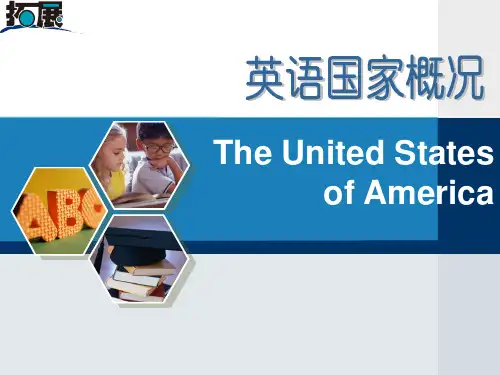
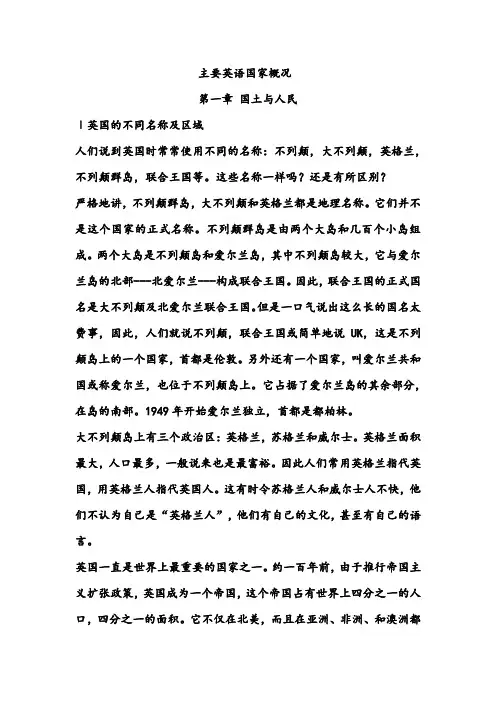
主要英语国家概况第一章国土与人民Ⅰ英国的不同名称及区域人们说到英国时常常使用不同的名称:不列颠,大不列颠,英格兰,不列颠群岛,联合王国等。
这些名称一样吗?还是有所区别?严格地讲,不列颠群岛,大不列颠和英格兰都是地理名称。
它们并不是这个国家的正式名称。
不列颠群岛是由两个大岛和几百个小岛组成。
两个大岛是不列颠岛和爱尔兰岛,其中不列颠岛较大,它与爱尔兰岛的北部---北爱尔兰---构成联合王国。
因此,联合王国的正式国名是大不列颠及北爱尔兰联合王国。
但是一口气说出这么长的国名太费事,因此,人们就说不列颠,联合王国或简单地说UK,这是不列颠岛上的一个国家,首都是伦敦。
另外还有一个国家,叫爱尔兰共和国或称爱尔兰,也位于不列颠岛上。
它占据了爱尔兰岛的其余部分,在岛的南部。
1949年开始爱尔兰独立,首都是都柏林。
大不列颠岛上有三个政治区:英格兰,苏格兰和威尔士。
英格兰面积最大,人口最多,一般说来也是最富裕。
因此人们常用英格兰指代英国,用英格兰人指代英国人。
这有时令苏格兰人和威尔士人不快,他们不认为自己是“英格兰人”,他们有自己的文化,甚至有自己的语言。
英国一直是世界上最重要的国家之一。
约一百年前,由于推行帝国主义扩张政策,英国成为一个帝国,这个帝国占有世界上四分之一的人口,四分之一的面积。
它不仅在北美,而且在亚洲、非洲、和澳洲都有殖民地。
但是两次世界大战大大削弱了英国,英国殖民地接二连三独立,大英帝国逐渐消失,1931年由英联邦所取代。
英联邦是一个自由联合体,由曾经是英国殖民地变为现已独立的国家构成。
成员国之间实行经济合作,有一定的贸易协议。
英联邦没有特别的权力,是否参加英联邦由各成员国自己决定。
目前(1991年),英联邦有50个国家。
Ⅱ英国的地方特征英国是个岛国,四周是海。
它位于欧洲北海岸附近的北大西洋中。
南面的英吉利海峡和东面的北海把英国与欧洲的其他部分隔开。
英法之间的英吉利海峡很狭窄,最狭窄的地方叫多佛尔海峡,只有33公里宽。
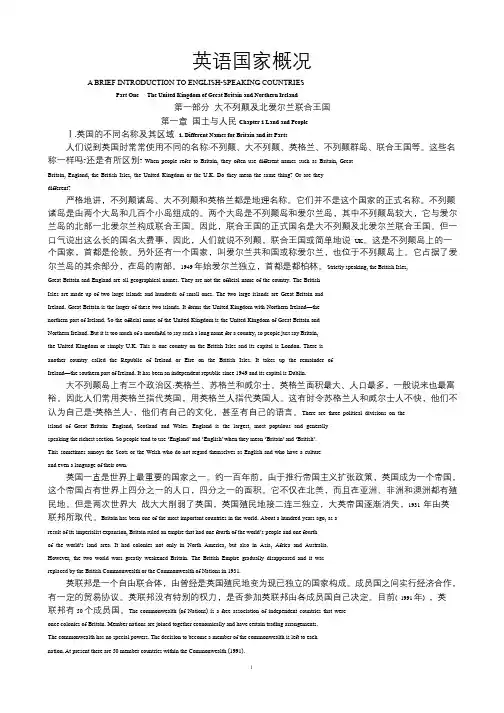
英语国家概况A BRIEF INTRODUCTION TO ENGLISH-SPEAKING COUNTRIESPart One The United Kingdom of Great Britain and Northern Ireland第一部分大不列颠及北爱尔兰联合王国第一章国土与人民Chapter 1 Land and PeopleⅠ.英国的不同名称及其区域 1. Different Names for Britain and its Parts人们说到英国时常常使用不同的名称:不列颠、大不列颠、英格兰、不列颠群岛、联合王国等。
这些名称一样吗?还是有所区别? When people refer to Britain, they often use different names such as Britain, GreatBritain, England, the British Isles, the United Kingdom or the U.K. Do they mean the same thing? Or are theydifferent?严格地讲,不列颠诸岛、大不列颠和英格兰都是地理名称。
它们并不是这个国家的正式名称。
不列颠诸岛是由两个大岛和几百个小岛组成的。
两个大岛是不列颠岛和爱尔兰岛,其中不列颠岛较大,它与爱尔兰岛的北部一北爱尔兰构成联合王国。
因此,联合王国的正式国名是大不列颠及北爱尔兰联合王国。
但一口气说出这么长的国名太费事,因此,人们就说不列颠,联合王国或简单地说UK。
这是不列颠岛上的一个国家,首都是伦敦。
另外还有一个国家,叫爱尔兰共和国或称爱尔兰,也位于不列颠岛上。
它占据了爱尔兰岛的其余部分,在岛的南部。
1949 年始爱尔兰独立,首都是都柏林。
Strictly speaking, the British Isles,Great Britain and England are all geographical names. They are not the official name of the country. The BritishIsles are made up of two large islands and hundreds of small ones. The two large islands are Great Britain andIreland. Great Britain is the larger of these two islands. It forms the United Kingdom with Northern Ireland—thenorthern part of Ireland. So the official name of the United Kingdom is the United Kingdom of Great Britain andNorthern Ireland. But it is too much of a mouthful to say such a long name for a country, so people just say Britain,the United Kingdom or simply U.K. This is one country on the British Isles and its capital is London. There isanother country called the Republic of Ireland or Eire on the British Isles. It takes up the remainder ofIreland—the southern part of Ireland. It has been an independent republic since 1949 and its capital is Dublin.大不列颠岛上有三个政治区:英格兰、苏格兰和威尔士。
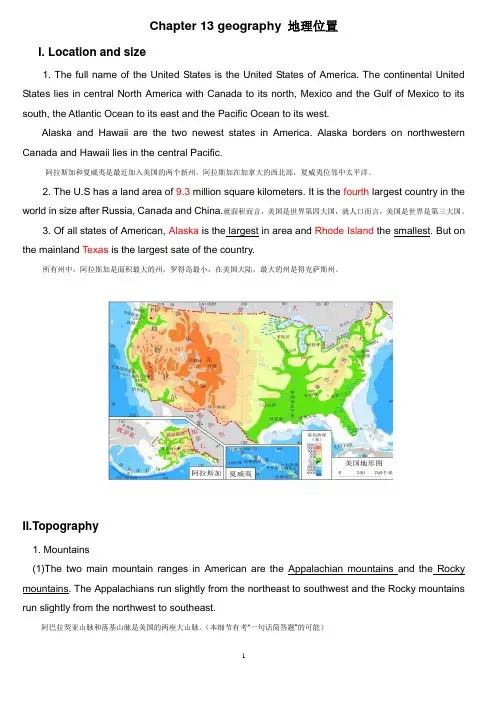
Chapter 13 geography 地理位置I. Location and size1. The full name of the United States is the United States of America. The continental United States lies in central North America with Canada to its north, Mexico and the Gulf of Mexico to its south, the Atlantic Ocean to its east and the Pacific Ocean to its west.Alaska and Hawaii are the two newest states in America. Alaska borders on northwestern Canada and Hawaii lies in the central Pacific.阿拉斯加和夏威夷是最近加入美国的两个新州。
阿拉斯加在加拿大的西北部,夏威夷位邻中太平洋。
2. The U.S has a land area of 9.3 million square kilometers. It is the fourth largest country in the world in size after Russia, Canada and China.就面积而言,美国是世界第四大国,就人口而言,美国是世界是第三大国。
3. Of all states of American, Alaska is the largest in area and Rhode Island the smallest. But on the mainland Texas is the largest sate of the country.所有州中,阿拉斯加是面积最大的州,罗得岛最小,在美国大陆,最大的州是得克萨斯州。
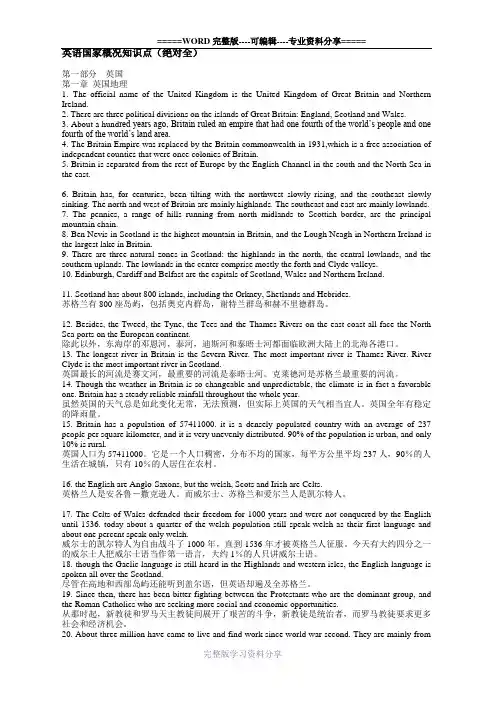
英语国家概况知识点(绝对全)第一部分英国第一章英国地理1. The official name of the United Kingdom is the United Kingdom of Great Britain and Northern Ireland.2. There are three political divisions on the islands of Great Britain: England, Scotland and Wales.3. About a hund red years ago, Britain ruled an empire that had one fourth of the world’s people and one fourth of the world’s land area.4. The Britain Empire was replaced by the Britain commonwealth in 1931,which is a free association of independent counties that were once colonies of Britain.5. Britain is separated from the rest of Europe by the English Channel in the south and the North Sea in the east.6. Britain has, for centuries, been tilting with the northwest slowly rising, and the southeast slowly sinking. The north and west of Britain are mainly highlands. The southeast and east are mainly lowlands.7. The pennies, a range of hills running from north midlands to Scottish border, are the principal mountain chain.8. Ben Nevis in Scotland is the highest mountain in Britain, and the Lough Neagh in Northern Ireland is the largest lake in Britain.9. There are three natural zones in Scotland: the highlands in the north, the central lowlands, and the southern uplands. The lowlands in the center comprise mostly the forth and Clyde valleys.10. Edinburgh, Cardiff and Belfast are the capitals of Scotland, Wales and Northern Ireland.11. Scotland has about 800 islands, including the Orkney, Shetlands and Hebrides.苏格兰有800座岛屿,包括奥克内群岛,谢特兰群岛和赫不里德群岛。
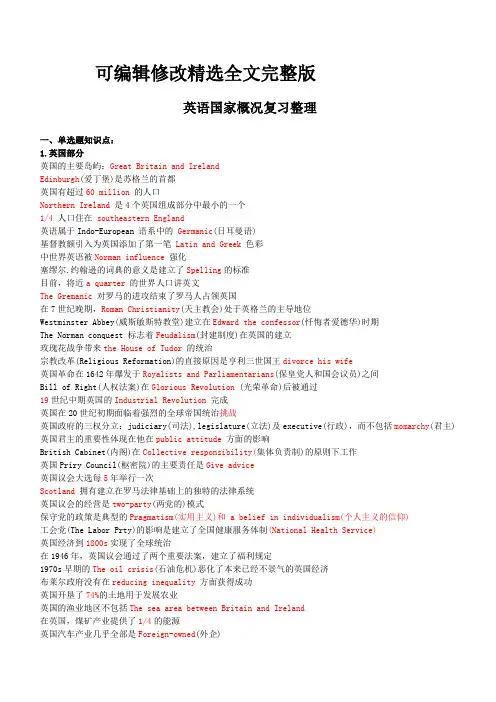
可编辑修改精选全文完整版英语国家概况复习整理一、单选题知识点:1.英国部分英国的主要岛屿:Great Britain and IrelandEdinburgh(爱丁堡)是苏格兰的首都英国有超过60 million的人口Northern Ireland是4个英国组成部分中最小的一个1/4 人口住在southeastern England英语属于Indo-European 语系中的Germanic(日耳曼语)基督教额引入为英国添加了第一笔 Latin and Greek色彩中世界英语被Norman influence强化塞缪尔.约翰逊的词典的意义是建立了Spelling的标准目前,将近a quarter的世界人口讲英文The Gremanic对罗马的进攻结束了罗马人占领英国在7世纪晚期,Roman Christianity(天主教会)处于英格兰的主导地位Westminster Abbey(威斯敏斯特教堂)建立在Edward the confessor(忏悔者爱德华)时期The Norman conquest 标志着Feudalism(封建制度)在英国的建立玫瑰花战争带来the House of Tudor的统治宗教改革(Religious Reformation)的直接原因是亨利三世国王divorce his wife英国革命在1642年爆发于Royalists and Parliamentarians(保皇党人和国会议员)之间Bill of Right(人权法案)在Glorious Revolution (光荣革命)后被通过19世纪中期英国的Industrial Revolution完成英国在20世纪初期面临着强烈的全球帝国统治挑战英国政府的三权分立:judiciary(司法),legislature(立法)及executive(行政),而不包括momarchy(君主) 英国君主的重要性体现在他在public attitude方面的影响British Cabinet(内阁)在Collective responsibility(集体负责制)的原则下工作英国Priry Council(枢密院)的主要责任是Give advice英国议会大选每5年举行一次Scotland拥有建立在罗马法律基础上的独特的法律系统英国议会的经营是two-party(两党的)模式保守党的政策是典型的Pragmatism(实用主义)和 a belief in individualism(个人主义的信仰)工会党(The Labor Prty)的影响是建立了全国健康服务体制(National Health Service)英国经济到1800s实现了全球统治在1946年,英国议会通过了两个重要法案,建立了福利规定1970s早期的The oil crisis(石油危机)恶化了本来已经不景气的英国经济布莱尔政府没有在reducing inequality方面获得成功英国开垦了74%的土地用于发展农业英国的渔业地区不包括The sea area between Britain and Ireland在英国,煤矿产业提供了1/4的能源英国汽车产业几乎全部是Foreign-owned(外企)英国文艺复兴时期最光辉的成就是drama(戏剧)"Preface to Lyrical Ballads"是浪漫诗的开篇之作Thomas Hardy 是19世纪批判现实主义的代表Waiting for Godot是Samuel Bekett 写的2.美国部分美国大陆上有48个statesAlaska是最大的州美国在 central North America ,加拿大在它的北面,墨西哥在南面,大西洋在它的东面,太平洋在它的西面美国最大的河流是Mississippi River哈佛、耶鲁和MIT等著名大学位于New EnglandNiagara Falls(尼亚加拉瀑布)位于美国-加拿大边境上阿拉斯加人口中没有the Blacks美国最大的少数民族是the Blacks1924年的移民法案限制美国的进一步移民,尤其是来自欧洲的美国文化主流的特点是:English-speaking,Western European,Protestant and Middle-class第一个北美殖民地建立在Jamestorn,VirginiaPilrim Fathers 是一群Paritans(清教徒),他们为了逃避在英国的迫害而来到美国7年战争发生在French and British之间"No taxation without represtation"是The people of 13 colonies的口号美国独立战争的第一枪在Lexingto (列克星顿)打响1775年5月,The second continenta congrsee 在Philadelphia举行林肯签发了Declaration of Independence承诺给予所以奴隶自由第二次世界大战开始时,美国是neutrality(中立的)政策Roosevelt(罗斯福)新政处理了大萧条的问题越南战争继续受Eisenhower,kennedy and johnson的影响美国的ore(矿石)只占世界很小部分现代美国经济经历了faming economy,handcraft economy,最终形成industrial economy第一家国家银行是在Alexander Hamilton时期建立的美国1/3粮食用于出口目前,美国出口占世界10%美国常规教育包括elementary,secondary and higher education美国高等教育开始于Harvard University 的建立MIT没有出过总统美国国庆节在July 4thWashington Irving 是美国文学之父Tony Morrison是第一个获得诺贝尔奖文学奖的非裔美国人二、名词解释:1. American Civil War(美国内战)American Civil War is a war that was fought in the US between 1861 and 1865 when 11 southern states rebelled against the federal government. The southern states were beaten, and as a result of the war, slaves became free.2.Melting pot and salad(大熔炉)The melting pot is an analogy for the way in which homogeneous societies develop, in which the ingredients in the pot (people of different cultures, races and religions) are combined so as to develop a multi-ethnic society. The term, which originates from the United States, is often used to describe societies experiencing large scale immigration from many different countries.3.American Constitution(美国宪法)American Constitution,which was drawn up in 1787 and came into effect in 1789,is the basic law of the land.For over two centuries,it has guided the development of government institution and has the basis for the nation,s political stability,economic growth and social progress.4.Cold War(冷战)In the spring of 1947 ,for the purpose of establishing the U.S.hegenmiony(霸权) in postwar world,President Truman declared the "Tueman Doctrine",aiming at expanding American sphere of influence.This marked the beginning of the Cold War period.the Cold War exerted great influence in Europe,and two Germanys were founded.Then,in April 1949,the U.S.allied with other Western countries,forming the North Atlantic Treaty Organization.While seeking to prevent Communist ideology from gaining further adherents(追随者) in Europe, the U.S.also responded to the challenges elsewhere.5.Thanksgiving(感恩节)Thanksgiving is a associated with the time when Europeans first came to the New World.In1620,the Mayflower arrived and brought about 150 Pilgrims.Life at the beginning was very hard and there was not enough food,so many of them died.During the following summer the Native Americans helped them and then they had a bountiful harvest.So they held a big celebration to thank God and the Native Americans.6.British Labor Party(英国工会党)British Labor Party known as a party of high taxation,was created by the growing trade union movement at the end of the 19th century.It quickly replaced the Liberal Party as one of the two largest political parties.The Labor government that come to power in 1945 had a major effort on British society. It set up the National Health Service.The party activities are largely funded by the trade unions.7.British Conservative Party(英国保守党)By and large, the Conservative Party is supported by those who have something to "conserve".Economically,the Conservative Party supports free enterprise and privatization of state-owned enterprise.It is against too much government intervention,especially nationalization.The Conservative Partyfavors reducing the influence of trade unions and minimizing expenditures on social welfare.Its policies are charactized by pragmatism and a belied in individualism.monwealth of Nations(联邦国家)The Commonwealth of Nations is a voluntary association of independent sovereign statse,all of which acknowledge the British monarch as the head.The Commonwealth is not a political union of any sort,and its member states have full autonomy to manage their internal and external affairs.It is primarily an organization in which countries with diverse economic backgrounds have an opportunity for close and equal interaction after gaining independence.The major activities of the Commonwealth are designed to advocate democracy,human rights,and to promote economic cooperation and growth within its members.9.Critical Realism(批判现实主义)The Critical Realism of the 19th centry flourished in the 1840s and the early 1850s.The Critical Realism described the chief traits of the society and criticized the capitalist system from a democratic viewpoint.The greatest English realist was Charles Dickens.10.Standard English (标准英语)Standard English is based on the speech of the upper class of southeastern England.It is widely used in media and taught at school .It is preferred by the educated,middle-class people .It has developed and has been promoted as a model for correct British English .It is also the norm carried overseas.Today Standard English is codified to the extent that the grammar and vocabulary are much the same everywhere in the world where English is thought and used.三、简答题:1.what is the full name of the UK?The full name is the United Kingdom of Great Britain and Northern Ireland2.why do tourists from all over the world like to go to Scotland?They like to enjoy the beautiful Scottish scenery ,to drink Scotch whisky and to see Scotsmen wearing kilts and playing bagpipes.3.How many periods can the development of the English language be divided into and what are they ?The development of the English language can be divided into three periods : Old English ,Middle English and Modern English.4.Why did English become more important after the Black Death?The laboring and merchant classes grew in economic and social importance after the Black Death,so English also grew in importance compare to French.。
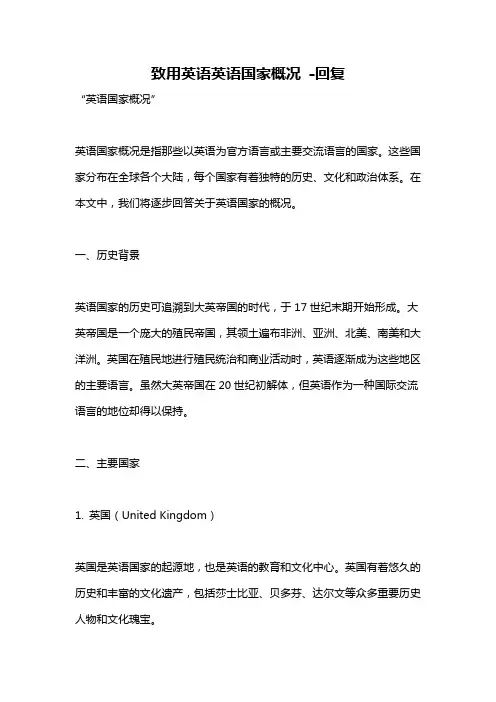
致用英语英语国家概况-回复“英语国家概况”英语国家概况是指那些以英语为官方语言或主要交流语言的国家。
这些国家分布在全球各个大陆,每个国家有着独特的历史、文化和政治体系。
在本文中,我们将逐步回答关于英语国家的概况。
一、历史背景英语国家的历史可追溯到大英帝国的时代,于17世纪末期开始形成。
大英帝国是一个庞大的殖民帝国,其领土遍布非洲、亚洲、北美、南美和大洋洲。
英国在殖民地进行殖民统治和商业活动时,英语逐渐成为这些地区的主要语言。
虽然大英帝国在20世纪初解体,但英语作为一种国际交流语言的地位却得以保持。
二、主要国家1. 英国(United Kingdom)英国是英语国家的起源地,也是英语的教育和文化中心。
英国有着悠久的历史和丰富的文化遗产,包括莎士比亚、贝多芬、达尔文等众多重要历史人物和文化瑰宝。
2. 美国(United States)美国是世界上最大的英语国家,拥有庞大的英语母语人口。
美国也是世界经济和科技的领袖之一,许多全球顶尖的大学和科技公司均位于美国。
3. 加拿大(Canada)加拿大是一个多语种国家,英语和法语是其官方语言。
英语在加拿大广泛使用,并且加拿大有许多英语为母语的人口,包括英国后裔和移民。
4. 澳大利亚(Australia)澳大利亚因其独特的自然环境和丰富的野生动植物而闻名于世。
英语是澳大利亚的主要语言,澳大利亚是一个多元文化的国家,吸引了许多国家的移民。
5. 新西兰(New Zealand)新西兰位于南半球,被太平洋环绕。
英语是该国的主要语言,新西兰受到其壮丽的自然景观、世界级的户外活动和友好的人民所吸引。
三、政治体系英语国家的政治体系多样,包括君主立宪制、共和制和议会制。
其中英国的政治体系是君主立宪制,美国是共和制,加拿大和澳大利亚是君主立宪制与议会制相结合,新西兰则是君主立宪制。
四、经济发展英语国家在世界经济中扮演着重要的角色。
例如,英国是欧洲最大的金融中心之一,美国是全球最大的经济体,加拿大是全球主要的资源出口国之一,澳大利亚是世界领先的矿产资源生产和出口国之一。
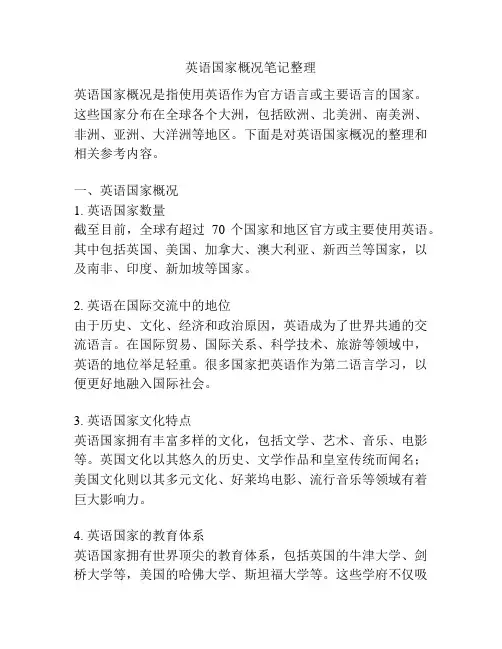
英语国家概况笔记整理英语国家概况是指使用英语作为官方语言或主要语言的国家。
这些国家分布在全球各个大洲,包括欧洲、北美洲、南美洲、非洲、亚洲、大洋洲等地区。
下面是对英语国家概况的整理和相关参考内容。
一、英语国家概况1. 英语国家数量截至目前,全球有超过70个国家和地区官方或主要使用英语。
其中包括英国、美国、加拿大、澳大利亚、新西兰等国家,以及南非、印度、新加坡等国家。
2. 英语在国际交流中的地位由于历史、文化、经济和政治原因,英语成为了世界共通的交流语言。
在国际贸易、国际关系、科学技术、旅游等领域中,英语的地位举足轻重。
很多国家把英语作为第二语言学习,以便更好地融入国际社会。
3. 英语国家文化特点英语国家拥有丰富多样的文化,包括文学、艺术、音乐、电影等。
英国文化以其悠久的历史、文学作品和皇室传统而闻名;美国文化则以其多元文化、好莱坞电影、流行音乐等领域有着巨大影响力。
4. 英语国家的教育体系英语国家拥有世界顶尖的教育体系,包括英国的牛津大学、剑桥大学等,美国的哈佛大学、斯坦福大学等。
这些学府不仅吸引着来自全球的学生,也为国际学生提供了优质的教育资源。
二、参考内容1. 英国英国是英语国家的发源地,拥有悠久的历史、文化和传统。
英国的教育体系著名于世,在全球范围内享有盛誉。
参考内容可包括英国的地理位置、历史概述、国家特色、名胜古迹、教育体系等。
2. 美国美国是使用英语的最大国家,也是世界上最强大的国家之一。
美国的文化多元,享有世界级的艺术、电影和音乐产业。
参考内容可包括美国的地理、历史、政治制度、经济实力、文化特点等。
3. 加拿大加拿大是英语国家中面积最大的国家,也是全球最宜居的国家之一。
加拿大的教育体系、医疗服务和社会福利享誉国际。
参考内容可包括加拿大的地理特点、历史发展、多元文化、经济实力等。
4. 澳大利亚澳大利亚是一个位于南半球的国家,英语是其官方语言。
澳大利亚是一个富有自然景观和野生动物资源的国家,吸引着来自世界各地的游客和留学生。
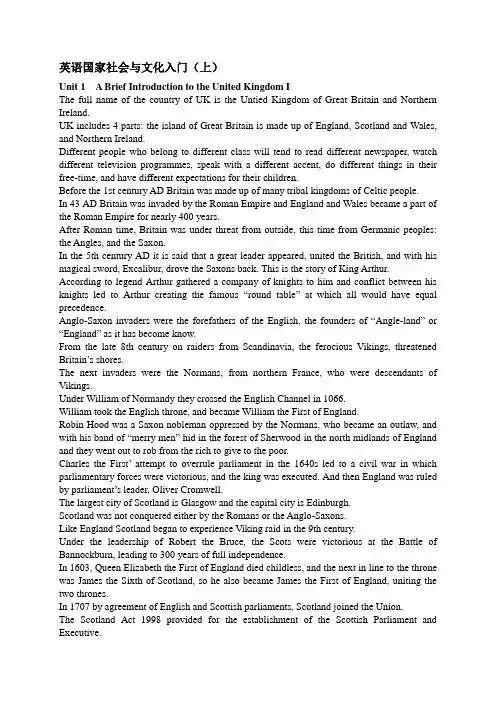
英语国家社会与文化入门(上)Unit 1 A Brief Introduction to the United Kingdom IThe full name of the country of UK is the Untied Kingdom of Great Britain and Northern Ireland.UK includes 4 parts: the island of Great Britain is made up of England, Scotland and Wales, and Northern Ireland.Different people who belong to different class will tend to read different newspaper, watch different television programmes, speak with a different accent, do different things in their free-time, and have different expectations for their children.Before the 1st century AD Britain was made up of many tribal kingdoms of Celtic people.In 43 AD Britain was invaded by the Roman Empire and England and Wales became a part of the Roman Empire for nearly 400 years.After Roman time, Britain was under threat from outside, this time from Germanic peoples: the Angles, and the Saxon.In the 5th century AD it is said that a great leader appeared, united the British, and with his magical sword, Excalibur, drove the Saxons back. This is the story of King Arthur. According to legend Arthur gathered a company of knights to him and conflict between his knights led to Arthur creating the famous ―round table‖at which all would have equal precedence.Anglo-Saxon invaders were the forefathers of the English, the founders of ―Angle-land‖ or ―England‖ as it has become know.From the late 8th century on raiders from Scandinavia, the ferocious Vikings, threatened Britain‘s shores.The next invaders were the Normans, from northern France, who were descendants of Vikings.Under William of Normandy they crossed the English Channel in 1066.William took the English throne, and became William the First of England.Robin Hood was a Saxon nobleman oppressed by the Normans, who became an outlaw, and with his band of ―merry men‖ hid in the forest of Sherwood in the north midlands of England and they went out to rob from the rich to give to the poor.Charles the First‘attempt to overrule parliament in the 1640s led to a civil war in which parliamentary forces were victorious, and the king was executed. And then England was ruled by parliament‘s leader, Oliver Cromwell.The largest city of Scotland is Glasgow and the capital city is Edinburgh.Scotland was not conquered either by the Romans or the Anglo-Saxons.Like England Scotland began to experience Viking raid in the 9th century.Under the leadership of Robert the Bruce, the Scots were victorious at the Battle of Bannockburn, leading to 300 years of full independence.In 1603, Queen Elizabeth the First of England died childless, and the next in line to the throne was James the Sixth of Scotland, so he also became James the First of England, uniting the two thrones.In 1707 by agreement of English and Scottish parliaments, Scotland joined the Union.The Scotland Act 1998 provided for the establishment of the Scottish Parliament and Executive.Scottish writes have given the world such well-known work as Walter Scott‘s romances of highland Scotland and ―Auld Lang Syne‖ (by Robert Burns)The capital city of Wales is Cardiff.Unit 2 A Brief Introduction to the United Kingdom IIThe capital city of Northern Ireland is Belfast.The most famous landmark of Northern Ireland is the ―Giant‘s causeway‖, a rocky promontory made up of black hexagonal columns.From the time of Queen Elizabeth I the new settlers, loyal to the British crown and Protestant in religious persuasion, were granted land, position, and privileges which had been systematically take away from the indigenous, Roman Catholic population.―Great hatred, little room‖ was the way the modern poet W. B. Yeats described the situation. Until 1921 the full name of the UK was ―The United Kingdom of Great Britain and Ireland‖, not only ―Northern Ireland‖, because the whole island of Ireland was politically integrated with Great Britain.The Easter Rising of 1916 was the most spectacular event, in which the rebels took over Dublin‘s Post Office, forcing the British to retake it by military means.In 1919 a group calling itself the IRA (Irish Republican Army) expanded the fighting.In the end the conflict became too great to ignore, and as the Sinn Fein party, who were supporters of the Irish terrorists, gained most of the Irish seats in the British parliament, Irish independence became inevitable.In 1921 the southern 26 counties formed an independent ―free state‖, while the 6 north-eastern counties remained a part the UK.In 1969, the first British soldiers were seen on Northern Irish streets.The official IRA thought enough progress had been made that they could concentrate on a political process, and run candidates for elections, but a strong faction felt that armed force was the only way to get the British out, and separated from the officials, calling themselves the ―Provisional IRA‖.In 1971 the Northern Irish government took the desperate step of imprisoning terrorist suspects from both sides without trial, a policy known as ―internment‖, which targeted primarily Catholic men in the North.In 1972 468 people were killed in Northern Ireland and that day has now been mythologiesed as ―Bloody Sunday‖, an important symbol of British oppression.In 1973, an agreement was reached between the main political parties in Northern Ireland, and importantly, the British and Irish governments, which led to a new form for the Northern Irish Parliament, with a Power-Sharing mechanism.The Sinn Fein party spoke of a twin campaign for union with Ireland, both political and military, which they called the policy of ―The Bullet and the Ballot Box‖.As a result of multi-party negotiations, aided this time by the intervention of the United States Senator George Mitchell, the Good Friday Agreement known also the Belfast Agreement, emerged on 10 April 1998.Unit 3 The Government of the United KingdomBritain is arguably the oldest representative democracy in the world, with roots that can be traced over a thousand years.The oldest institution of government is the Monarchy.The power of the monarchy was largely derived from the ancient doctrine of the ―divine right of kings‖The opposition was so powerful the king finally granted a gang of feudal barons and the Church a charter of liberty and political rights, still know by its medieval Latin name of Magna Carta, which is still regarded as Britain‘s key expression of the rights of citizens against the Crown.The civil war which brought the Roundheads to power in the 17th century was rooted in a dispute over the power of the king vis-à-vis Parliament.In 1689 Parliament passed the Bill of Rights which ensured that the King would never be able to ignore Parliament.In 1832, when a system for choosing the House of Commons by popular election replaced the monarch‘s job of appointing representatives, the modern political system was born.The party with the most supporters in the Commons forms the government, and by tradition, the leader of that party becomes Prime Minister.Britain is both a parliamentary democracy and a constitutional monarchy.British governance today is based upon the terms and conditions of the constitution.Israel and Britain are the only two countries without written constitutions of the sort which most countries have.The foundations of the British state are laid out in statute law, that is, laws passed by Parliament; the common laws, which are laws which have been established through common practice in the courts, not because Parliament has written them; and conventions, which are rules and practices which do not exist legally, but are nevertheless regarded as vital to the workings of government.Parliament is supreme in the British state because it alone has the power to change the terms of the Constitution.Strictly speaking, the Parliament today consists of the Queen, the House of Lords and the House of Commons.The role of the monarchy today is primarily to symbolize the tradition and unity of the British state.There are 724 Lords and 646 Members of Parliament in the House of Commons.Unit 4 Politics, Class and RaceIn 1928 it reached the current level of about 99% can vote (those excluded are Lords, certain categories of convicted criminals, the legally insane, and resident foreign citizens –except UK resident citizens of the Irish Republic)After a government has been in power for 5 years it has to resign and hold a ―general election‖, in which all British adults are given the chance to vote again for their constituency‘s MP.Anyone who is eligible to vote can stand as an MP. It is necessary only to make a deposit of 500 pounds which is lost if the candidate does not receive at least 5% of the vote.There are three major national parties: The Conservative party and the Labour party are the two biggest, and any general election is really about which of those two is going to govern. But there is a third important party, the Liberal Democrats.The Labour party is the newest of these three, created by the growing trade union movementat the end of the nineteenth century.The Conservative party is the party that spend most time in power.The Liberal Democrats are the third biggest party, and to some extent may be seen as a party of the ―middle‖, occupying the ideological ground between the two main parties.Margaret Thatcher is the UK‘s first woman Prime Minister.The car-worker probably reads a paper like The Sun: a newspaper with little heard news and more about TV soap operas, the Royal family, and sport. The university teacher might read The Guardian: a larger newspaper with longer stories, covering national and international news, ―high‖ culture such as theatre and literature, and so on.Unit 5 The UK EconomyThe UK is now the world‘s sixth largest economy.The UK is not only a member of the G7, G8, G20 major economies, but also a member of the World Trade Organization.Firstly, the country had gone heavily into debt in order to finance the war, selling many of its accumulated overseas assets, and borrowing large amounts from the United States and Canada.Secondly, the ear of empire was over. India, popularly known as ―The Jewel in the Crown‖ of the British Empire, gained its independence in 1947.Thirdly, despite the relatively rapid and trouble-free process of decolonization, Britain has still forced to maintain a substantial and expensive military presence in many overseas locations until the process was completed.Fourthly, although Britain was quite badly damaged by German bombing during the war, its industry survived comparatively unaffected. This failure to invest sufficiently in industry also reflects a long-standing and continuing problem in the UK economy.National economies can be broken down into three main areas: ―primary‖ industries, such as agriculture, fishing, and mining; ―secondary‖ industries, which manufacture complex goods from those primary products; and tertiary industries, often described as services, such as banking, insurance, tourism, and the selling of goods.Britain‘s agricultural sector is small but efficient, producing 58% of the UK‘s food needs with only 2% of its workforce.Scottish ports land the majority of the fish caught.Three of the biggest ten companies in Britain are to be found in the energy sector: Shell, British Petroleum (BP), and British Gas.The World‘s largest mining company, RTZ, is a UK company which operates mines all over the world.The British company Glaxo-Wellcome is the biggest drug company in the world.70% of the UK‘s workforce are employed in the service sector.London is one of the top three financial centres in the world. It has the greatest concentration of foreign banks in the world, accounts for 20% of all international bank-loans, and is the world‘s largest foreign exchange market. As well as banking, dealing in commodities and insurance are important processes in ―The City‖—the name given to the historic area at the centre of London where all this business is concentrated, at the heart of which is London Stock Exchange, one of the business share-dealing centres in the world.Aerospace is one of the UK‘s highest value adding manufacturing sectors.Unit 6 British LiteratureThe major literature competition is the annual Booker Prize.Much early British writing was concerned with Christianity: Anglo-Saxons produced beautifully illustrated versions of the Bible: the most famous of these is the Book of Kells. One of the oldest of these early ―Old English‖ litrary works is long poem from Anglo-Saxon times called Beowulf.One work from Norman Conquest times often studied today by middle school and college students is The Canterbury Tales by Geoffrey Chaucer, who was the first court poet to write in English.There was a general flowering of cultural and intellectual life in Europe during the 15th and 16th century which is known as ―The Renaissance‖.Christopher Marlowe‘s most famous play is The Tragical History of Doctor Faustus, the story of a man who sold his soul to the devil in return for power.William Shakespeare is probably the best-known literary figure in the world.The tragedies include Romeo and Juliet, Hamlet, Othello, King Lear, and Macbeth.Among the comedies are The Taming of the Shrew, A Midsummer Night‘s Dream, Twelfth Night, and The Tempest.A permanent monument of English literature style commemorates James‘s name. He ordered the translation of the Holy Scriptures known as the King James Bible(1611).The Essays of Frances Bacon made popular in English a literary form widely practiced afterward.The literary giant of the 17th century, John Milton was much bound up in Puritan Revolution. The most famous pamphlets is Areopagitica. During his retirement from public life he produced his masterpieces: Paradise Lost, its sequel, Paradise Regained, and the poetic tragedy Samson Agonistes.Johnthan Swift‘s name is linked with the fanciful account of four voyages known to us as Guliver‘s Travels.Scotland produced a much-loved poet, Robert Burns, who wrote in Scottish dialect.Daniel Defoe ‗s first and greatest novel appeared in 1719, which was Robinson Crusoe, the most famous tale of shipwreck and solitary survival in all literature.Two poets offered what had been called romantic poetry‘s ―Declaration of Independence.‖This was a volume of poems called Lyrical Ballads, written by William Wordsworth and Samuel Taylor Coleridge.George Gordon, Lord Byron‘s large body of work includes the partly autobiographical Childe Harold‘s Pilgrimage. Don Juan owed its title.John Keats‘s art is nowhere greater than in the two pomes ―Ode on a Grecian Urn‖ and ‖Ode to a Nightingale.‖Percy Bysshe Shelley‘s writing has a wide range. The lovely musical quality of his work appears in the fine verses of ―Ode to the West Wind‖ and ―To a Skylark‖The spirit of Romanticism also occurred in the novel, notably in Mary Shelley‘s (the poet Shelly‘s wife) Frankenstein, the story of science gone wrong through the disastrous consequences of an arrogant scientist‘s attempts to create life.Most of Sir Walter Scott‘s themes came from medieval and Scottish history and he wrote a number of romantic novels.Jane Austen, who excelled at this form of writing, is indeed one of the greatest of all Englishnovelists. A delightful, almost flawless stylist, she has devoted admirers of her Sense and Sensibility, Pride and Prejudice, and Emma, among other works.Perhaps the most famous literary family in British history are the Bronte sisters, and they too were influenced by the Romantic movement. Charlotte Bronte‘s Jane Eyre and Emily‘s Wuthering Heights are the most successful.Charles Dickens produced Pickwick Papers, Oliver Twist, David Copperfield and Great Expectations.Later in the 19th century Robert Louis Stevenson also wrote Scottish historical romances, The Adventures in Treasure Island and Kidnapped thrill readers young and old. His most famous short novel was The strange Case of Doctor Jekyll and Mr. Hyde.Among Thomas Hardy‘s better-known novels are The Return of the Native, Tess of the D‘urbervilles, and Jude the Obscure.20th century literature can be broadly divided into two stylistic periods: Modernism, and Postmodernism.One of the most famous of English modernist writers is Joseph Conrad, whose most famous novel is The Heart of Darkness.Virginia Woolf is another writer associated with Modernism, and one of the most famous writers of the century. Mrs. Dalloway, To the Lighthouse, and Orlando are among her best-known books.D.H. Lawrence wrote Sons and Lovers.Unit 7 British Education SystemMany people think school is just about teaching children what are often called ―the three Rs‖–―reading, riting and rithmetic‖. But the purpose of the British education system is also to socialize children.The school (or college) tie is a clear marker of social class.Education in the UK is compulsory. Children are legally obliged to attend school from the age of 5 (4 in Northern Ireland) to 16.State schools are funded by local and central government. The government also sometimes assists schools established by religious groups.In the private sector there are independent schools which are commonly, but confusingly, called public schools. Independent schools receive their funding through the private sector and through tuition rates, with some government assistance.Between the ages of 5 to 11, pupils mainly attend state sector primary schools.From the age of 11 up to around the age of 19, students attend secondary schools.General Certificate of Secondary Education are the main means of assessing pupils‘ progress in their final 2 years of compulsory education.Other pupils who decide not to go to university may choose to take vocational training.So far, the UK has only one privately funded university, the University of Buckingham. Oxford and Cambridge date from the 12th and 13 centuries.The Open University offers a non-traditional route for people to take university level courses and receive a university degree.Unit 8 The British MediaThe observer, which is still published every Sunday, first appeared in 1791, making it theworld‘s oldest Sunday newspaper, while The Times, which began publishing in 1785, is the United Kingdom‘s oldest daily newspaper.This watchdog function, keeping an eye on the government, is one of the reasons why a free press is considered so important to the functioning of parliamentary democracy.The British media all must follow the Advertising Code which ensure that advertisements are legal, decent, honest and truthful; have a sense of responsibility for consumer and society; and respect the principles of fair competition.Until the 1980s, almost all the national newspapers had their headquarters on or around Fleet Street in London, and sometimes you will hear newspaper culture referred to still as ―Fleet Street‖, or even, sometimes, the Street of Shame, reflecting the birth of scandals which take place.While officially speaking the British press is ―free‖ from government control and censorship and can print what it likes, there are limits to what will appear in the daily paper.The oldest and most popular soap, which began in the 1960s, is Coronation Street.The British Broadcasting Corporation –more familiarly known as the BBC or even ―the Beeb‖– us Britain‘s main public service broadcaster.The BBC is funded by license fees and viewers must buy a license each year for their TV set. Unit 9 Sports, Holidays and Festivals in Britain―Football hooligans‖, supporters of rival teams, sometimes clash before, during and after matches and occasionally run riot through the town, breaking windows and beating each other up.Wimbledon, actually a London suburb, is where the world‘s best players gather to compete on grass courts. It is one of the major events of the British sporting calendar and probably the most famous tennis event in the world.Cricket was one of the very first team sports in Britain to have organized rules and to be played according to the same rules nationally.The game of golf was invented by the Scottish.The true sport of British Kings and Queens is not skiing or golfing, but horse racing.There are two kinds of horse racing: flat racing, where horses and riders compete on a flat, oval track; and steeple-chasing, which is racing either across the countryside, or around a course designed to represent the obstacles you might encounter in the countryside. Christmas, December 25th, is the biggest and best loved British holiday.There are three Christmas traditions which are particularly British: one is the Christmas Pantomime, a comical musical play.Another British Christmas tradition is to hear the Queen give her Christmas message to her realm over the television and radio.A third British tradition, which is also celebrated in countries with British heritages, is Boxing Day, which falls on the day after Christmas.For church goers it is Easter, not Christmas, which is the most important Christian festival. One of Britain‘s most impressive and colourful festival happens on the second Saturday in June when the Queen‘s Birthday is officially celebrated by ―Trooping the Colour‖around Buckingham Palace in London.The UK, unlike most countries, does not have a ―national day‖.One truly English holiday is Bonfire Night –sometimes called Guy Fawkes Night –celebrated in the early autumn.The Twelfth is the high point of what is known as the Marching Season, when Protestant ―Orangemen‖ take to the streets wearing their traditional unifors of bowler hats, black suits and orange sashes, marching through the streets sing, banging durms and playing in marching bands.Northern Irish Catholics celebrate the birthday of the patron saint of Ireland, St Patrick, on March 17 each year.How Hogmanay is celebrated varies throughout Scotland, but one widely practiced is ―first footing‖.Each year Scottish people all over the world celebrate their most beloved national poet, Robert Burns, by holding a Burns Supper on the evening of his birthday.Halloween is a Scottish festival that comes from the great feast of the pagan Celts which marked the arrival of the winter half of the year.Wales has some of the oldest and richest literary, musical and poetic traditions in Europe.。
真正英语国家概况名词解释(全部版)美国部分1.Amerigo Vespucci---Amerigo Vespucci, a navigator, proved that the land was not India,but a new continent. Therefore, the land was named America after.2.the Mississippi---the mississippi has been called "father of waters" or "old man river",the mississippi and its tributaries drain one of the richest farm areas in the world.it is the most important river in the world.它与它的⽀流流经世界上最富饶的农业区之⼀。
3.Hispanics---it stands for the spanish-speaking population of the united states.these people mainly center in new mexico,california and texas.there are three major hispanic groups historically having the great influence on the us.they are chicanos,the puerto ricans and the cuban-americans.4.WASPS---WASPS are the mainstream americans,refering to the white Anglo-saxon protestants.5.baby boom--baby boom refers to the higher birth rate between 1946 and 1964.6.the great lakes---the great lakes are the most important lakes in the united states.they are lake superior,lake michigan,lake huron,lake Eire and lake ontario.7.Ellis island---Ellis island was an important immigration reception spot in the 1890 and at the turn of the century.8."the great compromise"---"the great compromise" of july 16,giving each state an equal vote in the Senate but making representation in the House reflect the size of each state's population. " ⼤妥协 ", 即参议院中各州有相同的选举权 , ⽽众议院代表应按各洲⼈⼝⽐例产⽣ .9.the Emancipation Proclamation---during the civil war,lincoln issued the Emancipation Proclamation to get more support for the union at home and abroad.It granted freedom to all slaves. 解放宣⾔ , 由林肯颁布 , 为了得到国内外对联邦的⽀持 . 解放宣⾔给了所有奴⾪以⾃由 .10.no taxtation without representation---that is ,without their representatives taking part in decisionmaking,they had no obligation to pay taxes.没有代表权不交税,就是说他们如果对殖民地的事务决策没有代表权,他们将没有义务缴纳税⾦.11.the Chinese Exclution Act---it was passed by the u.s congress in may1882,it stopped chinese immigration for ten years.排华法案在 1882 年5⽉由美国国会通过,它10 年内禁⽌中国移民⼊境.12.Indentured servants---indenture servants refer to some immigrants who has to work for a fixed term for their masters to repay the cross-atlantic fare and debts. 契约佣⼯,指⼀些移民必须要在⼀个限定的时期⾥为他们的雇主⼯作来偿还他们横渡⼤西洋的费⽤和债务.13.boston tea party( 考过 )---in 1773,when ships of tea reached boston and the governor was determind to see that tea was legally protected in its distribution,several dozen boston residents dressed as indians boarded the ships at night and threw $75,000 worth of tea into the harbor.this came to be known as the "boston tea party".波⼠顿倾茶事件, 1773 年,当满载茶叶的船只到达波⼠顿时,总督⼤⼈决定看看,以确保茶叶卸载时得到合法保护,晚上,⼏个波⼠顿居民化装成印度⼈来到船上仍掉了价值 75 , 000 的茶叶.这就是著名的波⼠顿倾茶事件.14.continental divide---it is an imaginary line that separates streams that flow into the pacific ocean from those that flow into the atlantic.那是⼀条难以想象的线,将流⼊太平洋和流⼊⼤西洋的河流划分开来.15.federalists---they were those who demanded a strong national system and who later struggle hard for the ratification of the consititution. 联邦制拥护者就是指那些要求建⽴坚固的国家体系,之后⼜为宪法的通过全⼒奋⽃的⼈.16.the gettysburg address---it refers to the short speech president lincoln made when he dedicated the national cemetery at gettysburg. He ended the speech with “the government of the people, by the people, for the people, shall not perish死亡 from the earth”.葛底斯堡(地址),指林肯在阵亡将⼠墓落成仪式上发表的⼀个简短的演说17.the ku klux klanthe kkk was the first organized in 1866 and then reformed in 1867.the kkk terrorized and attaked not only blacks,but also progressives,labor union organizers communist or socialist party members.三K党,最早成⽴在1866年,后在1867年重组,他们进⾏恐怖活动,不仅攻击⿊⼈、⽽且还迫害进步⼈⼠、⼯会组织者、社会主义和共产主义党派成员。
The United Kingdom of Great Britain andNorthern IrelandChapter 1 Geography, People and Language全名: the United Kingdom of Great Britain(大不列颠联合王国)and Northern Ireland(北爱尔兰).由成千上万的小岛组成(the British Isles). 两大岛屿:Great Britain(大不列颠)and Ireland(爱尔兰)The River Thames(second longest and most important), originates(起源于)in southwestern England -----North Sea.Scotland ( Edinburgh爱丁堡) important river:Clyde River kilts(苏克兰小短裙)Wales( Cardiff加迪夫,著名港口). The Severn River is the longest river of Britain------flow through western England.Northern Ireland(Belfast贝尔法斯特,首府) Lough Neagh----the largest lake in the British Isles.Climate: temperate, with warm summers, cool winters and plentiful precipitation(降雨量),冬暖夏凉,降雨充沛Three major features: winter fog, rainy day, instability 冬天多雾,常年多雨,天气不定London---Buckingham Palace(白金汉宫), Guildhall (市政厅), St. Paul’s Cathedral(圣保罗大教堂), The Tower Bridge of London(伦敦塔桥)The majority of the population is descendants of the Anglo-Saxons, a Germanic people from Europe.大部分的人口是盎格鲁-撒克逊人的后裔,从欧洲来的日耳曼人Most people in Wales and Scotland are descendants of the Celtic people, including the Irish people威尔士和苏格兰的大多数人都是凯尔特人的后裔,包括爱尔兰人English belongs to the Indo-European family of languages. English is in the Germanic group.英语属于日耳曼语语系Germanic group: East Germanic, North Germanic, West Germanic. English evolved from the West Germanic group.日耳曼语系:东日耳曼语,北日耳曼语,西日耳曼语。
《英美概况》 I. Multiple Choices: Choose one right answer from the four choices:
1. The highest mountain in Britain is ____. A. Scafell B. Ben Nevis C. the Cotswolds D. the Forth 2. The longest river in Britain is _____. A. the Clyde B. the Mersey C. the Severn D. the Thames 3. The largest lake in Britain is _____. A. the Lough Neage B. Windermere Water C. Coniston Water D. the Lake District
4. Which part of Britain is always fighting? A. England B. Scotland C. Wales D. Northem Ireland 5. The immigrants coming to Britain are mainly from _____. A. Europe B. the United States C. Africa D. the West Indies, 6. The first inhabitants in Britain were _____. A. the Normans B. the Celts C. the Iberians D. the Anglo-Saxons
7. British Recorded history began with _____. A. Roman invasion B. the Norman Conquest C. the Viking and Danish invasion D. the Anglo-Saxons invasion
8. In 829, _____ actually became the overlord of all the English. A. John B. James I C. Egbert D. Henry I 9. Christmas Day ____, Duke William was crowned in Westminster Abbey.
A. 1056 B. 1066 C. 1006 D. 1060 10. Henry II was the first king of the _____ dynasty. A. Windsor B. Tudor C. Malcolm D. Plantagenet 11. In 1265 ____ summoned the Great Council, which has been seen as the earliest parliament.
A. Henry III B. the Pope C. Barons D. Simon de Montfort 12. The Hundred Years’ war started in ____ and ended in ____, in which the English had lost all the territories of France except the French port of ____.
A. 1337, 1453, Flanders B. 1337, 1453, Calais C. 1346, 1453, Argencourt D. 1346, 1453, Brest
13. The Wars of Roses lasted for _____ years and king _____ was replaced by king _____.
A. 30, Richard III, Henry Tudor B. 50, Richard III, Henry Tudor B. C. 30, Richard I, Henry Tudor D. 50, Richard I, Henry Tudor
14. The Renaissance began in ____ in the early ____ century. A. England, 14 B. England, 15 C. Italy, 14 D. Italy, 15 15. The English Civil War is also called _____. A. the Glorious Revolution B. the Bloody Revolution C. the Catholic Revolution D. the Puritan Revolution 16. In _____, a small group of Puritans sailed from _____ in the Mayflower to be the first settlers in the North America.
A. 1620, London B. 1620, Plymouth C. 1720, London D. 1720, Plymouth 17. In the 18th century, there appeared ____ in England, which owed a great deal to the invention of machines.
A. the Industrial Revolution B. the Bourgeois Revolution C. the Wars of the Roses D. the Religious Reformation 18. English colonial expansion began with the colonization of _____ in 1583.
A. Canada B. Australia C. India D. Newfoundland 19. _____ was famous for his abdication because of his marriage with a divorced American:
A. Edward VIII B. Edward VII C. George VI D. George VII 20. In January _____ Britain became a member of the European Economic Community.
A. 1957 B. 1967 C. 1973 D. 1979 21. soon after _____, Britain not only gave up its econmic hegemony but also suffered a deep loss of its position of industrial leadership.
A. 1900 B. the First World War C. the Second World War D. 1960 22. In the 1970s among the developed countries, Britain maintained the lowest _____ rate and the highest _____ rate.
A. inflation, growth B. growth, inflation C. growth, divorce D. growth, birth
23. The following are all reasons of British decline of coal industry except _____.
A. the exhaustion of old mines B. costly extraction B. C. little money being invested D. the labour shortage
24. Britain’s foreign trade is mainly with _____. A. developing countries B. other Commonwealth countries C. other developed countries D. EC 25. The House of Lords is presided over by _____. A. the Lord Chancellor B. the Queen C. the Archbishop of Canterbury D. the Prime Minister
26. A General Election is held every _____ years and there are _____ members of Parliaments are elected.
A. five, 600 B. five, 650 C. five, 651 D. four, 651 27. The Prime Minister is appointed by _____ and he or she always sits in _____.
A. the Archbishop of Canterbury, the House of Commons B. the Archbishop of Canterbury, the House of Lords C. the Queen, the House of Commons D. the Queen, the House of Lords 28. The ultimate authority for law-making resides in _____. A. the Queen B. the Cabinet C. the House of Lords D. the House of Commons
29. The sources of British law include _____. A. statutes, common law, equity law and European Community law
B. statutes, common law and equity law C. statutes, common law and European Community law D. a complete code and statutes 30. In criminal trials by jury, _____ passes sentenced and _____ decide the issue of guilt or innocence.